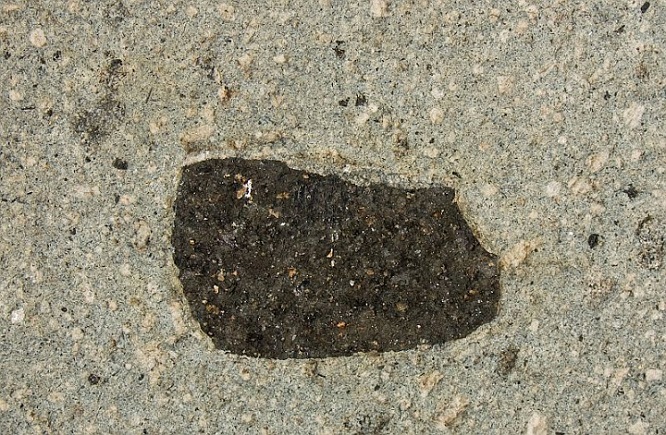Xenoliths
Xenolith is rock fragment within an intrusive igneous body that is unrelated to the igneous body itself. Xenoliths, which represent pieces of older rock incorporated into the magma while it was still fluid, may be located near their original positions of detachment or may have settled deep into the intrusion, if their density is greater.There are three principal types of xenoliths:1) Restite material, the refractory residue brought up from the site of mantle ore crustal melting.
2) Totally exotic material, ripped off the walls of conduits or the walls or roof of a magma chamber.
3) Cognate material, representing perhaps an accumulation of crystals already formed in a magma chamber, later ripped up during fresh magma movement.
Xenolith that are not in equilibrium with the magma may melt, dissolve or react, and these processes may lead to their eventual assimilation. Therefore the absence of xenolith does not necessarily indicate that no contamination of magma occurred. It may in fact mean that numerous xenoliths were totally assimilated. On the other hand, the presence of numerous xenoliths does not necessarily imply the magma has been severely contaminated. They may have been incorporated without much reaction just before magma solidification.
Xenoliths can be assimilated in three ways:
• Melting: Take for example a quartz-feldspar sandstone incorporated in an intermediate magma at 800°C and with a water pressure of 2Kbar; quartz, plagioclase and Orthose individually melt at temperature in excess of 800°C, but minimum-melting-point mixtures of quartz with either one or both feldspar, or feldspar with feldspar all form at temperature <800°C. This means that melting could occur everywhere quartz and feldspar or two feldspar are in contact. Evidence of melting is sometime preserved as a film of glass along grain boundaries, and if reaction take place in association with the melting, a spongy (Sieve) texture also develops along xenolith margins.
• Solution: Solution differs from melting in that it takes place only where the xenolith contacts magma (at its margins). The process will not in itself lead to a disaggregation of a xenolith. Xenocrysts wich undergo such solution become rounded just like some phenocrysts during magma mixing.
• Reaction: Like solution, sometime take place only where xenolith contacts magma. For example, the reaction of quartz with basic magma produces pyroxenes, usually as a fine-grained aggregate encrusting the margins of xenolith or xenocrysts.
Some basaltic magmas are extruded on the Earth’s surface carrying pieces of the mantle, called mantle xenoliths. These xenoliths make it possible to estimate how rapidly these magmas ascended from depth to the surface, because the upward flow of magma must exceed the settling velocity of the xenoliths. Two magma types, alkali basalt and kimberlite, commonly carry such mantle xenoliths. Both originate by small degrees of partial melting in the upper mantle near the base of the lithosphere.
The common occurrence of dense mantle xenoliths in tephra and lava flow eruptions of alkali basalt indicates that this magma carried them from depth. An average settling rate for xenoliths of different sizes can be calculated by balancing the different forces on the xenoliths during ascent, and by making certain assumptions about the rheologic properties of the magma. Calculation indicates that a 20-cm-wide xenolith will settle at a rate of 0.1 m/s. Obviously, the magma ascent rate would have to be greater in order to carry the xenolith to the surface; the xenolith settling velocity gives a minimum estimate of magma ascent rate.
.jpg)
Peridotite xenoliths in basalt, Hawaii, 2009 eruption. From AGU blogosphere.
.jpg)
Dunite xenolith in basaltic lava from Hawaii. From Sand Atlas.br />

Pyroxenite xenolith in trachyte. From Sand Atlas.br />
.jpg)
Sedimentary xenoliths in a Orendite lamproite, Wyoming, USA. From Wikipedia.br />
Bibliography
• Cox et al. (1979): The Interpretation of Igneous Rocks, George Allen and Unwin, London.
• Howie, R. A., Zussman, J., & Deer, W. (1992). An introduction to the rock-forming minerals (p. 696). Longman.
• Le Maitre, R. W., Streckeisen, A., Zanettin, B., Le Bas, M. J., Bonin, B., Bateman, P., & Lameyre, J. (2002). Igneous rocks. A classification and glossary of terms, 2. Cambridge University Press.
• Middlemost, E. A. (1986). Magmas and magmatic rocks: an introduction to igneous petrology.
• Shelley, D. (1993). Igneous and metamorphic rocks under the microscope: classification, textures, microstructures and mineral preferred-orientations.
• Vernon, R. H. & Clarke, G. L. (2008): Principles of Metamorphic Petrology. Cambridge University Press.


.jpg)
.jpg)
.jpg)
.jpg)
.jpg)

.jpg)
.jpg)
.jpg)
.jpg)
.jpg)
.jpg)
.jpg)
.jpg)
.jpg)
.jpg)
.jpg)
.jpg)
.jpg)
.jpg)
.jpg)
(1).jpg)
(2).jpg)
(3).jpg)
(4).jpg)
(5).jpg)
(6).jpg)
(7).jpg)
(8).jpg)
(9).jpg)
(11).jpg)
(12).jpg)
(13).jpg)
(18).jpg)
(19).jpg)
(22).jpg)